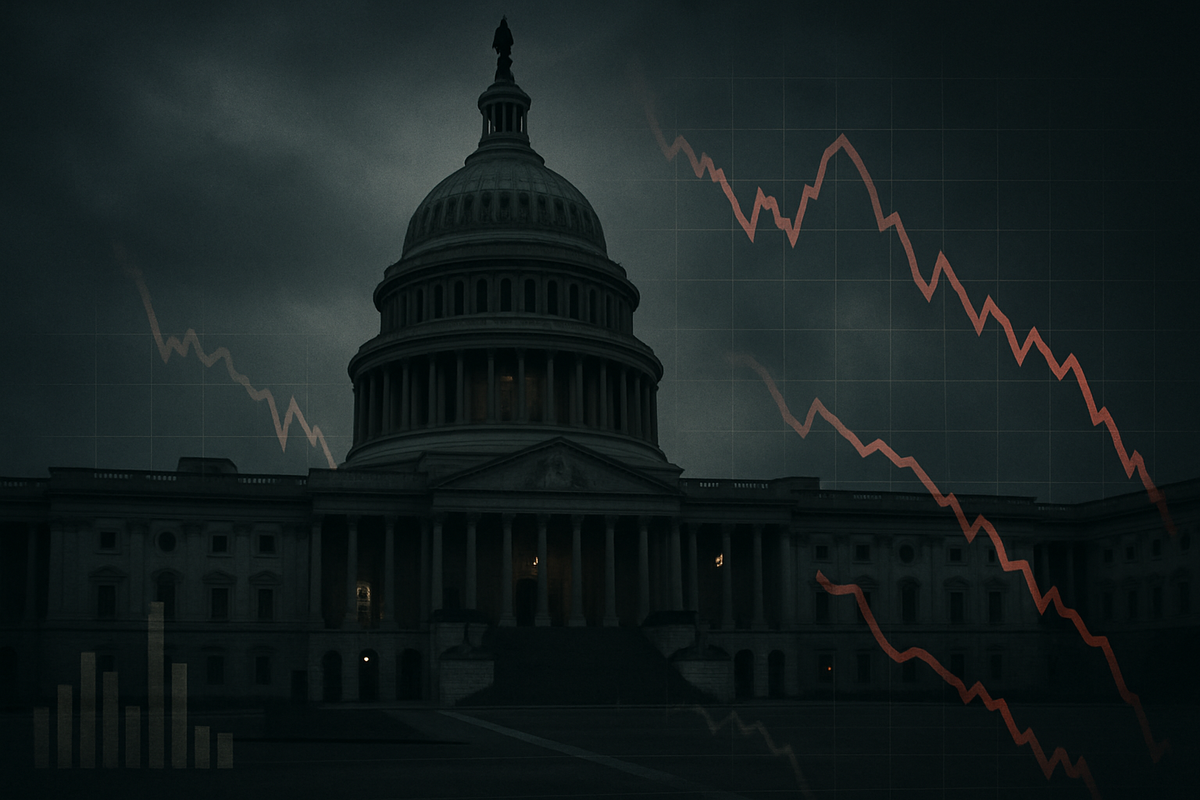
As of October 1, 2025, the United States federal government has entered a state of shutdown, marking the first such occurrence since 2018-2019. This fiscal impasse, triggered by Congress's failure to enact appropriations legislation for the 2026 fiscal year, plunges the nation into a period of significant uncertainty. The immediate implications are widespread, affecting hundreds of thousands of federal workers, disrupting essential government services, and casting a shadow over the broader economic landscape.
The primary sticking point in congressional negotiations leading to this shutdown revolves around contentious disagreements over healthcare funding, particularly the future of Affordable Care Act (Obamacare) subsidies. With federal agencies directed to execute their shutdown plans, the nation braces for a cascade of disruptions that will touch everything from economic data releases to the daily lives of citizens.
Unpacking the Shutdown: A Deep Dive into the Disruption
A U.S. government shutdown commences when Congress and the President fail to agree on either a full set of 12 annual appropriations bills or a temporary continuing resolution by the September 30th deadline, the close of the fiscal year. This failure leads to a lapse in funding, compelling federal agencies to cease all non-essential discretionary functions. Each agency, guided by the Office of Management and Budget (OMB), implements its own shutdown plan, delineating which activities can continue and which must halt.
The timeline leading to this moment typically involves a year-long budget process that often goes awry. From agencies submitting budget proposals in early fall to the President's budget request in February, through congressional committee hearings and the drafting of appropriations bills, the path to October 1st is fraught with potential for political deadlock. When September 30th arrives without a resolution, the government, as we now see, shuts down.
Key players in this high-stakes political drama include the President, who must sign all funding legislation; the House of Representatives and the Senate, whose bipartisan agreement is essential; and the leaders of both political parties, whose partisan gridlock often fuels these impasses. Federal agencies themselves become crucial stakeholders, tasked with implementing shutdown plans, while hundreds of thousands of federal employees and contractors bear the immediate financial brunt. The public, too, is a significant stakeholder, experiencing direct impacts on services and economic stability. Initial market reactions are typically "risk-off," characterized by increased volatility, an initial stock market sell-off, a rally in U.S. Treasuries as investors seek safe havens, and potential weakness in the U.S. dollar. Crucial economic data releases are often delayed, leaving investors and policymakers in the dark.
Winners and Losers: Corporate Fortunes in a Furloughed Nation
A government shutdown invariably creates a landscape of winners and losers among public companies, primarily dictated by their reliance on federal contracts, regulatory processes, and overall economic stability.
Companies heavily dependent on government contracts are typically the most vulnerable. Lockheed Martin (NYSE: LMT), as the largest federal contractor, faces significant risks from budgetary constraints and potential payment delays for programs like the F-35. Other defense giants like RTX Corporation (NYSE: RTX) and Northrop Grumman (NYSE: NOC) are similarly exposed. IT service providers to federal agencies, such as Leidos Holdings (NYSE: LDOS), Booz Allen Hamilton (NYSE: BAH), and Science Applications International Corp. (NASDAQ: SAIC), could see their revenue streams impacted by project stoppages and delayed payments. Even Boeing (NYSE: BA), despite its commercial jet business, has substantial defense contracts and could face delays in certifications from furloughed Federal Aviation Administration (FAA) employees, impacting plane deliveries.
The healthcare sector also faces volatility. While essential services continue, companies like UnitedHealth (NYSE: UNH), a major provider of Medicare Advantage plans, could be negatively affected by furloughed Centers for Medicare & Medicaid Services staff, potentially delaying claims processing and audits. Industries requiring regulatory approvals or inspections, such as pharmaceutical and biotech firms like Pfizer (NYSE: PFE), could experience significant delays in new drug approvals or market entry if the FDA's operations are curtailed. The airline industry, including major carriers like United Airlines (NASDAQ: UAL), Delta Air Lines (NYSE: DAL), American Airlines (NYSE: AAL), and Southwest Airlines (NYSE: LUV), faces indirect impacts from delayed FAA hiring and training, and potential airport security disruptions. Small businesses relying on federal loan programs (e.g., SBA loans) are particularly vulnerable to funding freezes and payment delays.
Conversely, certain sectors or companies may be less affected or even see increased interest. "Safe-haven" assets often benefit, meaning gold mining companies like Barrick Gold (NYSE: GOLD) and Newmont (NYSE: NEM) could see increased investor interest. Companies with diverse revenue streams or those providing essential private sector services that are not directly government-dependent tend to be more resilient. While not a direct "winner," private sector data providers, such as Automatic Data Processing (NASDAQ: ADP), might see their employment reports gain increased scrutiny if government economic data is delayed.
Wider Significance: Ripples Across Industries and Global Markets
The U.S. government shutdown is more than a domestic political squabble; it's an event with far-reaching implications that intertwine with broader industry trends, trigger ripple effects on global competitors and partners, and carry significant regulatory and policy consequences, all while drawing comparisons to historical precedents.
Economically, shutdowns typically lead to a temporary dip in GDP growth, with estimates suggesting a reduction of 0.1 to 0.2 percentage points for each week of disruption. While some of this lost GDP may be recovered, a prolonged shutdown can result in permanent economic losses, as seen in the $3 billion permanently shaved off GDP during the 2018-2019 shutdown. Consumer confidence invariably declines, impacting spending. Beyond the immediate financial costs, shutdowns can erode public trust in government and employee morale, sending a damaging signal about political dysfunction in the world's largest economy.
The ripple effects extend globally. Shutdowns can trigger market volatility internationally, with a "risk-off" response impacting bond prices and leading to a sell-off in global stock markets. The U.S. dollar, as the world's reserve currency, is vulnerable to perceived instability, potentially leading to capital shifts towards other major currencies. Regulatory delays can hinder U.S. firms, potentially creating competitive advantages for international rivals in less regulated environments. Furthermore, disruptions to immigration services, visa processing, and critical information sharing can strain international engagements and partnerships.
From a regulatory standpoint, numerous federal agencies curtail operations, suspending non-essential services. This means delays in FDA and EPA inspections, potential impacts on the Securities and Exchange Commission (SEC) Division of Corporation Finance, and disruptions to immigration services handled by the Department of Labor (DOL) and U.S. Citizenship and Immigration Services (USCIS). Crucially, the delay or outright postponement of key economic data releases (jobs, CPI, GDP) leaves policymakers and investors without vital information.
Historically, the U.S. has experienced over 20 funding gaps since 1976, with 10 leading to visible government shutdowns. Notable examples include the 1995-1996 shutdowns under President Clinton and the Republican Congress, the 16-day shutdown in 2013 over the Affordable Care Act, and the record 35-day shutdown in 2018-2019 over border wall funding. While short shutdowns have often had limited lasting market impact, a prolonged shutdown, especially if combined with existing economic vulnerabilities, could have more significant consequences. It's also vital to distinguish a government shutdown from a debt ceiling crisis; while both stem from fiscal disagreements, a shutdown is a lapse in spending authority, whereas a debt ceiling crisis concerns the government's ability to borrow to pay existing bills, posing a far greater systemic risk.
What Comes Next: Navigating the Uncharted Waters
The current government shutdown on October 1, 2025, sets the stage for a period of both immediate challenges and evolving long-term possibilities, demanding strategic pivots and careful navigation from all sectors.
In the short term, the duration of the shutdown will be paramount. A swift resolution (a few days to a week) would likely lead to temporary disruptions and a quick market rebound, consistent with historical patterns. However, a prolonged impasse would deepen the economic drag, potentially leading to more significant and unrecoverable reductions in GDP growth. The financial strain on furloughed federal employees and contractors will intensify, impacting local economies. Critical services, from passport processing to certain healthcare approvals and scientific research, will continue to face delays. The "data blackout" will persist, complicating the Federal Reserve's ability to make informed monetary policy decisions.
Looking ahead, the long-term possibilities include potential permanent economic damage, particularly if the shutdown causes significant layoffs beyond temporary furloughs, as has been hinted at. This could erode the government's capacity to perform its core tasks and further undermine public trust. Industries reliant on federal grants or approvals could see innovation stifled.
Strategic adaptations are crucial. Businesses, especially federal contractors, must build financial resilience, diversify revenue streams, and meticulously review contract clauses. Diversifying away from government-dependent income sources and strengthening supply chain resilience will be key. Individuals, particularly federal employees, are advised to maintain robust emergency savings. Investors should consider diversifying portfolios, potentially increasing exposure to safe-haven assets like gold, and focusing on defensive sectors.
Market opportunities, though limited, may emerge in sectors less reliant on federal spending or those offering solutions to challenges exacerbated by the shutdown, such as private sector data analytics or security services in the absence of government data. However, the overarching challenge will be managing increased market volatility, the information void created by delayed economic data, and the potential for disruptions in the IPO market and corporate earnings for government-dependent firms. The U.S. dollar's stability could also be tested.
Comprehensive Wrap-up: Assessing the Impact and Investor Outlook
The U.S. government shutdown, commencing October 1, 2025, is a significant event with immediate and potential long-term repercussions for the economy and financial markets. The key takeaway is the inherent uncertainty and disruption it introduces, stemming from political gridlock over critical fiscal issues like healthcare funding. While historical precedents suggest that short shutdowns often have limited lasting market impact, the current environment, with existing economic headwinds and the explicit threat of permanent layoffs, could amplify its severity.
Moving forward, the market's trajectory will largely hinge on the duration of this shutdown. A swift resolution would likely see a quick recovery in market sentiment and a reversal of initial "risk-off" movements. However, a prolonged impasse would deepen economic losses, erode consumer and business confidence, and potentially lead to more persistent market instability. The absence of crucial economic data will continue to challenge investors and policymakers, making informed decisions more difficult.
The lasting impact of this shutdown will extend beyond mere economic figures. It risks further eroding public trust in government's ability to govern effectively and could have a detrimental effect on federal employee morale and retention. Globally, it projects an image of political dysfunction, potentially undermining international confidence in the stability of the U.S. economy.
Investors in the coming months should meticulously watch for signs of progress in congressional negotiations, as a resolution remains the primary catalyst for market recovery. Close attention should be paid to economic data releases once they resume, particularly those related to inflation, employment, and GDP, as these will guide the Federal Reserve's monetary policy. Corporate earnings reports and forward guidance, especially from companies with significant government exposure, will provide crucial insights into the shutdown's impact on specific sectors. Furthermore, investors should monitor overall market volatility, the performance of safe-haven assets, and any renewed discussions around the U.S. debt ceiling, which could add another layer of fiscal uncertainty. While maintaining a diversified, long-term investment strategy is generally advisable, active monitoring of these factors will be critical for navigating the evolving landscape.
This content is intended for informational purposes only and is not financial advice.


















